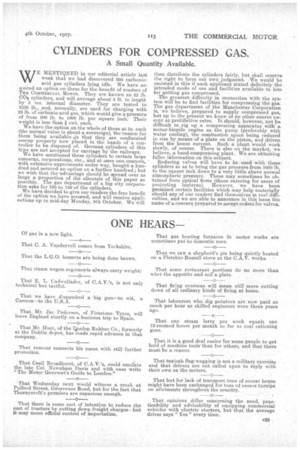CYLINDERS FOR COMPRESSED GAS.
Page 3

If you've noticed an error in this article please click here to report it so we can fix it.
A Small Quantity Available.
WE MENTIQNED in our editorial article last week that we had discovered 366 -carbonic-. acid gas cylinders lying idle. We have acquired an option on these for the benefit of readers of THE COMMERCIAL MOTOR. They are known as 22 lb. CO g cylinders, and will average about 4 ft. in length by 5 ins, internal diameter. They are tested to 3300 lb., and, normally, are used for charging with 22 lb. of Carbo-nic-acid gas' which would give a pressure of from 900 lb. to 1000 lb. per square inch: Their weight is less than f cwt. each.
We -have the option on the whole of these at Sr. each (the normal value is about a so-vereign), the-reason for them being available is that they are confiscated enemy property now placed in the hands of a controller to be disposed of. German cylinders of this type are not accepted for carriage by the railways. We have mentioned these cylinders to certain large concerns, corporations, etc., and at once one concern, with extensive experiments under way, bought a hundred and secured an option on a further hundred,; but we wish that the-advantage should be spread over as large a proportion of the clientele of this paper as possible. The gas department of a big city corporation asks for 100 to 150 of the cylinders.
We have decided to give our readers the free benefit of the option we have secured, and will receive applications up to mid-day Monday, 8th October. We will then distribute the cylinders fairly, but shall reserve the right to form our own judgment. We would be assisted in this if each applicant stated definitely the intended mode of use and facilities available to him for getting gas compressed.
The greatest difficulty in connection with the system will-be to find facilities for compressing the gas. The gas department of the Manchester Corporation is, we believe, prepared to supply compressed gas, but up to the present we know of no other source except at prohibitive rates. It should, however, not be difficult to rig up a compressing apparatus with" a, motor-bicycle engine as the pump (preferably with water cooling), the combustion space being reduced in size by means of a plate on the piston, and driven from the house current. Such a plant would work slowly, of course. There is also on the market, we believe, a hand-compressing plant. We are obtaining fuller information on this subject.
Reducing valves will have to be used with these cylinders so as to bring the gas pressure from 1000 lb. to the square inch, down to a very little above normal atmospheric pressure. These may sometimes be obtained from optical firms (those catering for users of projecting lanterns). However, we have been promised certain facilities which may help materially should any of our readers find themselves in real difficulties, and we are able to announce in this issue the name of a concern prepared to accept orders for valves.
























